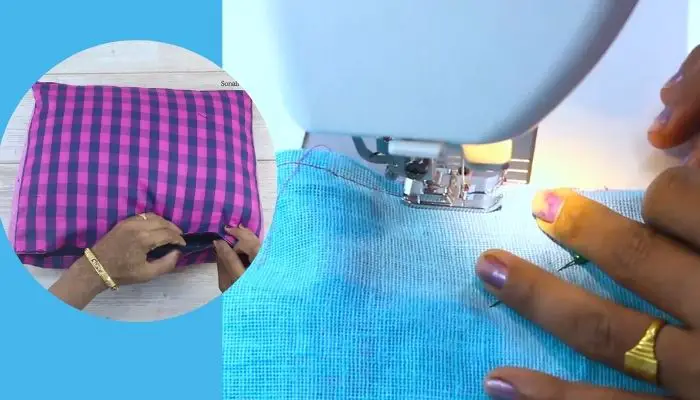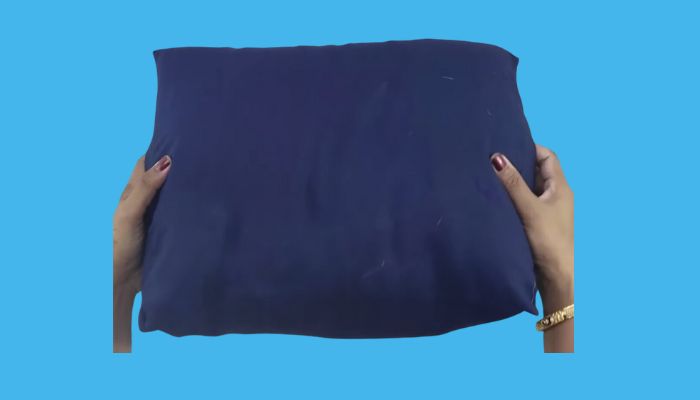DIY Wedge Pillow. A good night’s sleep is vital for overall health and well-being. During sleep, our bodies repair and rejuvenate. Insufficient sleep can lead to various health problems, including weakened immune function, mood disturbances, and cognitive impairment. Adequate rest is essential for physical, mental, and emotional balance, contributing to our ability to function optimally throughout the day. Yet, many struggle to achieve restful sleep due to various factors, including discomfort and improper support while lying down.
Introducing Wedge Pillows as a Solution:
Enter the wedge pillow—a simple yet effective solution for improving sleep quality. Unlike traditional pillows, wedge pillows are designed to provide elevated support, offering a gentle incline that can alleviate common sleep-related issues such as snoring, acid reflux, and back pain. Wedge pillows help keep airways open by elevating the upper body, reducing the likelihood of snoring and promoting smoother breathing. The inclined position can also prevent stomach acid from refluxing into the esophagus, relieving those who suffer from acid reflux or GERD. Moreover, the elevated support provided by wedge pillows can help alleviate pressure on the lower back, making them beneficial for individuals with back pain or discomfort.
Posing the Main Question: “Why Buy One When You Can Craft It Yourself?”
Given the importance of quality sleep and the benefits of wedge pillows, it’s natural to seek solutions to improve sleep comfort. While commercial wedge pillows are readily available, crafting your own DIY wedge pillow presents several advantages. It allows for customization to suit individual preferences and needs. It provides a sense of satisfaction and accomplishment in creating something explicitly tailored for personal comfort. Moreover, crafting a DIY wedge pillow can be a cost-effective alternative to purchasing one, particularly for those with access to the necessary materials or who are willing to repurpose items they already own. Thus, the question arises: Why buy a wedge pillow when you can embark on a DIY journey to better sleep and improved comfort?
Materials Needed: To start, you’ll need:
- High-density foam
- Fabric for the cover
- Measuring tape
- Electric knife or scissors
- Sewing machine or needle and thread
- Zipper or Velcro (optional)
High-Density Foam
When embarking on your DIY wedge pillow project, the first essential item on your list is high-density foam. High-density foam provides the necessary firmness and support to ensure your wedge pillow maintains its shape and effectively supports your body during sleep. Opting for high-density foam over regular foam ensures durability and longevity, preventing the pillow from flattening over time. Additionally, high-density foam offers superior pressure relief, making it ideal for alleviating discomfort associated with conditions like acid reflux or snoring. When selecting high-density foam for your wedge pillow, consider the desired thickness and density to achieve the perfect balance of support and comfort for your needs.
Fabric for the Cover
Another crucial component of your DIY wedge pillow is the fabric for the cover. The cover adds a decorative touch and serves as a protective barrier for the foam. When choosing fabric, opt for materials that are soft, breathable, and easy to clean. Cotton or linen fabrics are popular choices due to their comfort and durability. Additionally, consider the aesthetic appeal of the fabric, selecting colours or patterns that complement your bedroom decor. Ensure the fabric is sufficient to fully cover the foam wedge and allow easy insertion and removal. If you prefer a removable cover for convenience and washing purposes, consider adding a zipper or Velcro closure to one side of the cover for easy access.
Measuring Tape
Accurate measurements are essential for creating a well-fitted wedge pillow that provides optimal support and comfort. A measuring tape is indispensable for determining the dimensions of the foam wedge and the fabric cover. Measure the foam wedge’s length, width, and height to ensure precise cutting and sewing of the cover. Additionally, use the measuring tape to calculate the desired incline or angle of the wedge pillow, depending on your specific sleep needs and preferences. Take your time with measurements to avoid any errors that could impact the final result of your DIY project.
Electric Knife or Scissors
You’ll need either an electric knife or a pair of sharp scissors to shape the high-density foam into the desired wedge form. An electric knife offers precision and ease of use, allowing you to smoothly cut through the foam with minimal effort. However, you don’t have access to an electric knife. In that case, sharp scissors can also achieve clean cuts, albeit with more manual effort. Whichever tool you choose, ensure it is sharp and can cut through the dense foam without causing jagged edges or uneven surfaces.
Sewing Machine or Needle and Thread

Creating a custom cover for your DIY wedge pillow requires basic sewing skills and the appropriate tools. A sewing machine offers efficiency and speed, allowing you to stitch the fabric cover with precision and durability. If you don’t own a sewing machine, don’t fret; a needle and thread can accomplish the task with patience and care. Whether using a sewing machine or hand-sewing, ensure you use strong, durable thread that can withstand regular use and washing. Take time to sew the cover neatly and securely, paying attention to details like seam allowances and stitching techniques to achieve professional-looking results.
Zipper or Velcro (Optional)
Consider adding a zipper or Velcro closure to your DIY wedge pillow cover for added convenience and versatility. A zipper allows for easy insertion and removal of the foam wedge, making it effortless to clean or replace the cover as needed. Similarly, Velcro provides a secure closure while offering the flexibility to easily open and close the cover. Whether opting for a zipper or Velcro, ensure the closure is sturdy and securely attached to the fabric cover to prevent any shifting or loosening over time. Additionally, consider the placement of the closure to ensure it does not interfere with the comfort or aesthetics of the pillow.
Step-by-Step Guide to Crafting Your DIY Wedge Pillow
Cutting the Foam:
To begin your DIY wedge pillow project, the first step is cutting the foam to the desired size and angle. High-density foam is commonly used for wedge pillows as it provides the necessary support and maintains its shape over time. Suppose you don’t have access to an electric knife, the preferred tool for cutting foam due to its precision and ease of use. In that case, you can still achieve clean cuts with a serrated bread knife or sturdy scissors. Measure the dimensions of your wedge pillow carefully, ensuring that the angles are suitable for your intended use, whether for elevating your head or providing lumbar support. Take your time with this step to ensure accuracy, as it will determine the comfort and effectiveness of your finished pillow.
Sewing the Cover:
Once you’ve cut the foam to the desired shape, the next step is sewing the cover. Choose a fabric that is durable, comfortable, and easy to wash, as the cover will protect the foam and enhance the aesthetics of your pillow. Measure and cut the fabric according to the dimensions of your foam, adding extra allowance for seams. If you’re proficient with a sewing machine, stitch the fabric along the edges, leaving one side open for inserting the foam. Alternatively, you can hand-stitch the cover using a needle and thread if you don’t have access to a sewing machine. Consider adding a zipper or Velcro closure to the open side for easy removal and washing of the cover. Insert the foam carefully once the cover is securely attached, ensuring a snug fit. Your DIY wedge pillow is ready to provide personalized comfort and support for a restful night’s sleep.
Read more about Best wedge pillow
Customization Tips: Crafting Your Perfect Pillow

When it comes to crafting your DIY wedge pillow, customization is critical to ensuring optimal comfort and satisfaction. One of the most significant advantages of making your own pillow is the ability to tailor it to your preferences and needs. Firstly, consider adjusting the incline of your wedge pillow to suit your sleeping position and any specific health concerns you may have. For instance, if you suffer from acid reflux or GERD, a steeper incline might be beneficial to alleviate symptoms by keeping your upper body elevated. On the other hand, a lower incline might be more comfortable for those who prefer a less pronounced elevation.
Fabric choice is another crucial aspect of customization. Selecting the suitable fabric adds a personal touch to your pillow and affects its overall feel and durability. Opt for soft, breathable materials like cotton or linen for maximum comfort, especially if you sleep hot. Additionally, consider incorporating personal touches such as decorative patterns or textures to complement your bedroom decor and add a touch of style to your DIY creation. By customizing your wedge pillow to your liking, you can create a sleep accessory that provides comfort and enhances your bedroom’s aesthetic appeal.
Maintenance and Care: Preserving Your DIY Creation
Proper maintenance and care are essential for ensuring the longevity and performance of your DIY wedge pillow. To keep your pillow clean and hygienic, it’s crucial to wash the cover regularly. Choose a fabric that is easy to clean and can withstand frequent washing, such as machine-washable cotton or polyester blends. Additionally, consider using a waterproof liner to protect the foam or stuffing from spills and accidents, especially if you’re prone to nighttime mishaps or have young children or pets in the house.
In addition to washing the cover, it’s essential to maintain the integrity of the pillow itself. Depending on the materials used, you may need to fluff or reshape the pillow periodically to prevent it from becoming flattened or distorted over time. If your DIY wedge pillow loses its firmness or support, consider replacing the foam or stuffing to ensure continued comfort and effectiveness. By following these maintenance tips, you can prolong the life of your DIY creation and enjoy restful nights of sleep for years to come.
DIY Wedge Pillow Cover
Creating a DIY wedge pillow cover is an essential aspect of the overall project, as it adds aesthetic appeal and provides protection and comfort. When selecting fabric for the cover, it’s crucial to choose a material that is durable, breathable, and easy to wash. Cotton or linen fabrics are popular choices due to their softness and breathability, which can enhance the overall comfort of the pillow. Additionally, consider incorporating a zipper or Velcro closure to allow for easy removal and washing of the cover.
When sewing the cover, ensure it is tailored to fit snugly over the foam insert, with enough room for the pillow to maintain its shape without being too tight. Pay attention to seams and stitching to ensure durability and longevity. Adding decorative elements such as piping or decorative stitching can elevate the aesthetic appeal of the pillow cover, making it a stylish addition to your bedroom decor.
Regularly maintaining the DIY wedge pillow cover is essential to keep it clean and hygienic. Remove the cover periodically for washing, following the care instructions for the fabric to avoid damage or shrinkage. Consider using a gentle detergent and washing on a delicate cycle to preserve the fabric’s integrity. Air drying or using a low-heat setting on the dryer can help prevent shrinkage and maintain the shape of the cover over time.
DIY Wedge Pillow for Baby
Crafting a DIY wedge pillow for a baby can provide comfort and support during sleep or playtime. Safety is paramount when making a wedge pillow for a baby. Ensure the materials are non-toxic and hypoallergenic to minimize the risk of allergic reactions or respiratory issues. Opt for firm foam or padding to provide adequate support for the baby’s head and neck, reducing the risk of flat head syndrome or discomfort during sleep.
Consider the size and shape of the wedge pillow to ensure it fits securely in the baby’s crib or bassinet without posing a suffocation hazard. Avoid using loose fabrics or embellishments that could detach and become a choking hazard. It’s also essential to monitor the baby’s use of the wedge pillow and discontinue use if any signs of discomfort or distress are observed.
To maintain a safe sleep environment for the baby, regularly inspect the DIY wedge pillow for signs of wear and tear and replace it as needed. Washing the cover regularly can help keep the pillow clean and hygienic, reducing the risk of allergens or bacteria buildup. With proper care and attention to safety, a DIY wedge pillow can provide added comfort and support for your baby’s sleep needs.
DIY Wedge Pillow Pattern
Creating a DIY wedge pillow pattern is the first step in crafting a custom pillow that meets your needs and preferences. When designing a pattern for your wedge pillow, consider factors such as the desired incline, dimensions, and shape. Start by sketching out a rough design on paper, considering the angle at which you want the pillow to incline and the dimensions of the foam insert or stuffing.
Once you have a basic outline of the pattern, transfer it onto the fabric, leaving extra space for seam allowances. Cut out the fabric pieces according to your pattern, ensuring accuracy and precision to achieve a professional-looking finish. If you’re new to sewing or pattern-making, consider using a pre-made pattern template or tutorial to guide you through the process.
Experiment with different fabrics and textures to find the perfect combination for your DIY wedge pillow. Soft, breathable fabrics like cotton or jersey are ideal for pillow covers. In contrast, sturdy materials like canvas or upholstery fabric can provide added durability for the pillow base. Consider incorporating decorative elements such as piping, ruffles, or embroidery to add personality and flair to your design.
Regularly test your DIY wedge pillow pattern for fit and comfort, making adjustments to achieve the desired level of support and stability. With practice and patience, you can create a custom wedge pillow that looks great and provides optimal comfort and support for a restful night’s sleep.
DIY Wedge Pillow Bed Frames
Incorporating DIY wedge pillow bed frames into your bedroom decor can elevate your sleep space’s aesthetic appeal and functionality. When designing and building a DIY wedge pillow bed frame, consider factors such as the size of your mattress, the desired angle of incline, and the materials and tools needed for construction.
Start by measuring your mattress’s dimensions to determine the bed frame size needed. Then, calculate the angle of incline based on your preferences and any specific sleep issues you may be addressing, such as acid reflux or snoring. Remember that a gradual incline of 30 to 45 degrees is typically recommended for optimal comfort and support.
Choose sturdy, durable, and easy-to-work materials for your DIY wedge pillow bed frame. Standard options include wood, metal, or PVC pipe, depending on your budget and design aesthetic. Once you have gathered your materials, follow a step-by-step construction plan, measuring and cutting each component accurately for a precise fit.
Assemble the bed frame according to your design specifications, ensuring stability and structural integrity. Consider adding additional features such as built-in storage compartments or decorative elements like headboards or footboards to enhance the overall look and functionality of the bed frame. Once complete, test the bed frame for stability and comfort. Make any necessary adjustments before adding bedding and accessories for the finishing touch. With careful planning and craftsmanship, a DIY wedge pillow bed frame can transform your bedroom into a cozy and stylish retreat for rest and relaxation.
Final Thought
Crafting Your Path to Comfort
In conclusion, creating your own DIY wedge pillow offers numerous benefits beyond achieving better sleep. By engaging in this DIY project, you’re customizing a solution tailored to your specific needs and fostering a deeper connection with your sleep environment. Crafting a wedge pillow allows you to take control of your comfort, ensuring that every aspect of the pillow, from its incline to its fabric, reflects your preferences and requirements. This personalized touch extends beyond mere functionality; it instils ownership and pride in the final product, enhancing overall satisfaction with your sleep setup.
Encouraging DIY for Improved Comfort
As we wrap up our exploration of DIY wedge pillows, consider embarking on your own DIY journey towards better sleep and improved comfort. While purchasing a pre-made wedge pillow may seem convenient, the experience of crafting one yourself offers unparalleled rewards. Not only does it empower you to actively participate in enhancing your sleep quality, but it also fosters creativity and resourcefulness. By embracing the DIY approach, you save costs and gain invaluable skills and a deeper appreciation for the effort invested in creating a personalized sleep solution. So, seize this opportunity to transform your sleep experience by delving into the world of DIY wedge pillows and discover the joy of crafting a space that truly caters to your comfort needs.
These expanded sections provide a detailed insight into the benefits of crafting a DIY wedge pillow and encourage readers to take on the challenge themselves for a more fulfilling sleep experience.
FAQs (Frequently Asked Questions):
How do I choose the right incline?
Consider your specific needs, such as addressing reflux or snoring, when determining the optimal incline.
Can I use regular pillow stuffing instead of foam?
Explain why foam is recommended for maintaining the pillow’s shape and effectiveness.
What if I don’t have an electric knife for cutting the foam?
Provide a simple alternative, such as using a serrated bread knife.
How do I ensure the cover stays clean over time?
Consider using washable fabrics and incorporating a waterproof liner for added protection.
Is making a DIY wedge pillow cheaper than buying one?
Highlight the potential cost savings, especially when utilizing repurposed materials.
